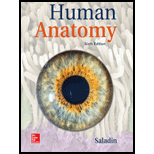
The distinction between the axial and appendicular skeletons
To write:
About the distinction between the axial and appendicular skeletons.
Introduction:
The skeletal system is divided into two regions, namely, the axial skeleton and the appendicular skeleton. The main difference is that the axial skeleton forms the central supporting axis of the body which includes the skull, vertebral column and the thoracic cage (the ribs and the sternum). The appendicular skeleton includes the bones in the upper limb, pectoral girdle, bones of the lower limb and pelvic girdle.
Explanation of Solution
The axial skeleton holds 80 bones, which includes the bones of the head and trunk of the vertebrae. The axial skeleton is composed of five divisions, which are the skull bones (cranial bones and facial bones), the auditory ossicles, hyoid bone, vertebral column (cervical vertebrae, thoracic vertebrae, lumbar vertebrae, sacrum and coccyx) and the thoracic cage.
The appendicular system is the part of the skeletal system which consists of the bones that support the appendages which hold a majority number of bones, with a total of 126 bones. This system includes the skeletal elements of the upper and lower limbs, pectoral girdle and pelvic girdle.
The axial skeleton and the appendicular skeleton together form the entire skeletal system, which has a total number of 206 bones.
Want to see more full solutions like this?
Chapter 7 Solutions
Human Anatomy
- What is behavioral adaptarrow_forward22. Which of the following mutant proteins is expected to have a dominant negative effect when over- expressed in normal cells? a. mutant PI3-kinase that lacks the SH2 domain but retains the kinase function b. mutant Grb2 protein that cannot bind to RTK c. mutant RTK that lacks the extracellular domain d. mutant PDK that has the PH domain but lost the kinase function e. all of the abovearrow_forwardWhat is the label ?arrow_forward
- Can you described the image? Can you explain the question as well their answer and how to get to an answer to an problem like this?arrow_forwardglg 112 mid unit assignment Identifying melting processesarrow_forwardGive only the mode of inheritance consistent with all three pedigrees and only two reasons that support this, nothing more, (it shouldn't take too long)arrow_forward
- Oarrow_forwardDescribe the principle of homeostasis.arrow_forwardExplain how the hormones of the glands listed below travel around the body to target organs and tissues : Pituitary gland Hypothalamus Thyroid Parathyroid Adrenal Pineal Pancreas(islets of langerhans) Gonads (testes and ovaries) Placentaarrow_forward
- Understanding Health Insurance: A Guide to Billin...Health & NutritionISBN:9781337679480Author:GREENPublisher:Cengage
 Medical Terminology for Health Professions, Spira...Health & NutritionISBN:9781305634350Author:Ann Ehrlich, Carol L. Schroeder, Laura Ehrlich, Katrina A. SchroederPublisher:Cengage Learning
Medical Terminology for Health Professions, Spira...Health & NutritionISBN:9781305634350Author:Ann Ehrlich, Carol L. Schroeder, Laura Ehrlich, Katrina A. SchroederPublisher:Cengage Learning  Human Biology (MindTap Course List)BiologyISBN:9781305112100Author:Cecie Starr, Beverly McMillanPublisher:Cengage Learning
Human Biology (MindTap Course List)BiologyISBN:9781305112100Author:Cecie Starr, Beverly McMillanPublisher:Cengage Learning Anatomy & PhysiologyBiologyISBN:9781938168130Author:Kelly A. Young, James A. Wise, Peter DeSaix, Dean H. Kruse, Brandon Poe, Eddie Johnson, Jody E. Johnson, Oksana Korol, J. Gordon Betts, Mark WomblePublisher:OpenStax College
Anatomy & PhysiologyBiologyISBN:9781938168130Author:Kelly A. Young, James A. Wise, Peter DeSaix, Dean H. Kruse, Brandon Poe, Eddie Johnson, Jody E. Johnson, Oksana Korol, J. Gordon Betts, Mark WomblePublisher:OpenStax College





